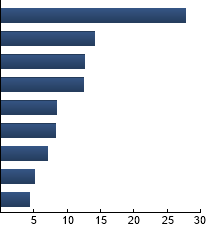|
|
 |
|
Investment Objective/Strategy - The First Trust Bloomberg Shareholder Yield ETF (the "Fund") seeks investment results that correspond generally to the price and yield (before the Fund's fees and expenses) of an equity index called the Bloomberg Shareholder Yield Index (the "Index"). Under normal conditions, the Fund will invest at least 80% of its net assets (plus any borrowings for investment purposes) in the securities that comprise the Index.
There can be no assurance that the Fund's investment objectives will be achieved.
- The Bloomberg Shareholder Yield Index is constructed to track the performance of US large and mid-cap companies that have a track record of returning value to shareholders in the form of dividends, buybacks, as well as debt reduction, and in a manner that is within their capacity.
- The starting universe consists of all the securities comprising the Bloomberg US Large- and Mid-Cap universe excluding real estate investment trusts (“REITs”) and those securities that do not meet the size and liquidity standards of the index.
- To be included in the index, a security must have, over each of the trailing five years:
- positive free cash flow;
- positive total returned capital;
- a capacity of under 150%;
- a shareholder yield between 0.5% and 15%.
- The 50 securities with the highest levels of total returned capital are selected and assigned a weight based upon their level of shareholder yield, with those securities with higher shareholder yield assigned greater weight.
- No security’s weight shall exceed 5% and no sector’s weight shall exceed 30%.
- The index is rebalanced and reconstituted quarterly.
| Ticker | SHRY |
| Fund Type | Large Cap Equity |
| Investment Advisor | First Trust Advisors L.P. |
| Investor Servicing Agent | Bank of New York Mellon Corp |
| CUSIP | 33738R761 |
| ISIN | US33738R7614 |
| Intraday NAV | SHRYIV |
| Fiscal Year-End | 03/31 |
| Exchange | Nasdaq |
| Inception | 6/20/2017 |
| Inception Price | $19.83 |
| Inception NAV | $19.83 |
| Rebalance Frequency | Quarterly |
| Total Expense Ratio* | 0.60% |
* As of 8/1/2024
| Closing NAV1 | $42.02 |
| Closing Market Price2 | $42.01 |
| Bid/Ask Midpoint | $42.01 |
| Bid/Ask Discount | 0.02% |
| 30-Day Median Bid/Ask Spread3 | 0.29% |
| Total Net Assets | $21,008,178 |
| Outstanding Shares | 500,002 |
| Daily Volume | 115 |
| Average 30-Day Daily Volume | 449 |
| Closing Market Price 52-Week High/Low | $42.09 / $30.71 |
| Closing NAV 52-Week High/Low | $42.09 / $30.71 |
| Number of Holdings (excluding cash) | 50 |
| Holding |
Percent |
| Altria Group, Inc. |
5.11% |
| Ameriprise Financial, Inc. |
4.89% |
| Principal Financial Group, Inc. |
4.87% |
| Charter Communications, Inc. (Class A) |
3.96% |
| Cardinal Health, Inc. |
3.73% |
| EOG Resources, Inc. |
3.36% |
| HP Inc. |
3.12% |
| LyondellBasell Industries N.V. |
3.12% |
| McKesson Corporation |
2.96% |
| Kinder Morgan, Inc. |
2.95% |
* Excluding cash.
Holdings are subject to change.
Past performance is not indicative of future results.
| Maximum Market Cap. | $3,434,767 |
| Median Market Cap. | $103,386 |
| Minimum Market Cap. | $18,847 |
| Price/Earnings | 16.59 |
| Price/Book | 3.69 |
| Price/Cash Flow | 12.21 |
| Price/Sales | 1.14 |
|
|
2023 |
Q1 2024 |
Q2 2024 |
Q3 2024 |
| Days Traded at Premium |
105 |
21 |
31 |
33 |
| Days Traded at Discount |
145 |
40 |
32 |
31 |
|
Financials
|
27.80%
|
|
Health Care
|
14.03%
|
|
Information Technology
|
12.55%
|
|
Consumer Staples
|
12.45%
|
|
Industrials
|
8.38%
|
|
Energy
|
8.26%
|
|
Communication Services
|
7.12%
|
|
Consumer Discretionary
|
5.06%
|
|
Materials
|
4.35%
|
|

|
Tracking Index: Bloomberg Shareholder Yield Index
Nasdaq Riskalyze US Large Cap™ Index - The Index is a modified market capitalization weighted index which seeks to provide a diversified portfolio of dividend-paying US large cap securities. S&P 500® Index - The Index is an unmanaged index of 500 companies used to measure large-cap U.S. stock market performance.
|
|
The information presented is not intended to constitute an investment recommendation for, or advice to, any specific person. By providing this information, First Trust is not undertaking to give advice in any fiduciary capacity within the meaning of ERISA, the Internal Revenue Code or any other regulatory framework. Financial professionals are responsible for evaluating investment risks independently and for exercising independent judgment in determining whether investments are appropriate for their clients.
|